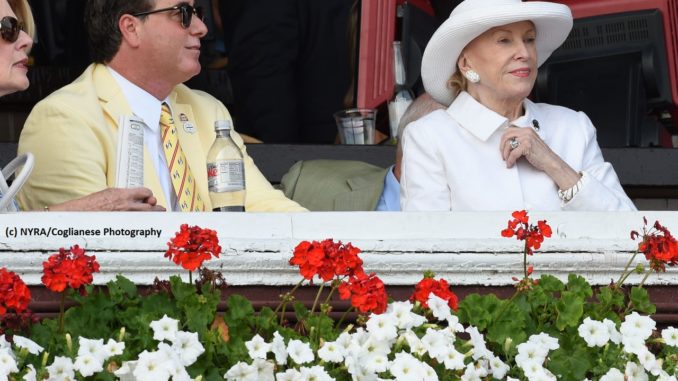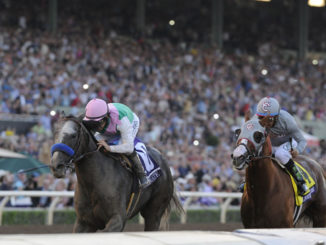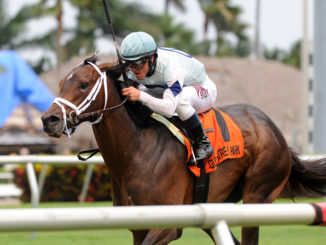
by TERESA GENARO
SARATOGA SPRINGS, N.Y. — When the death of Marylou Whitney was announced on July 19 at Saratoga, tributes and obituaries appeared not just in Saratoga Springs, her hometown, but also in newspapers nationwide, from the Palm Beach Post, the paper of her winter home, to the Sacramento Bee. The woman known locally simply as “Marylou” was a woman of national interest, if news reports are any indication.
But Saratoga has long claimed her as her own. She spent much of the year at Cady Hill, the estate originally owned by her second husband, Cornelius Vanderbilt Whitney, and she was a generous and active philanthropist, supporting the National Museum of Racing, the Saratoga Performing Arts Center, the Museum of Dance, and Saratoga Hospital.
The affluent socialized with her; the rest of us watched from afar, or sometimes, up close, as she arrived to her annual ball the night before the Whitney Stakes in Congress Park, in the middle of downtown, amid spectators who lined the park’s entrance. When she was in town, she frequented local restaurants with her husband John Hendrickson, and we tried not to gawk or eavesdrop too much when we ended up seated next to her.
Among her frequent stops were the Wishing Well and the Brook Tavern, both owned by the Lee family.
“She came to the Brook all the time,” said dining room manager Carol Ann Micari. “When she walked in on John’s arm, people in the bar would greet her, and she was always so gracious, stopping to say hello and ask people how they were.”
In recent years, Whitney spent Sunday night dinners at a locale far off the usual Saratoga beaten path: under a white tent near the backstretch Rec Hall, at the meals she, Hendrickson, and local restaurants provided for backstretch workers.
“For the past 12 years, she and John sponsored backstretch appreciation events,” said Paul Ruchames, executive director of Backstretch Employees Service Team. “She wanted it to be like a real outdoor café, with tablecloths and good food. That meant a lot to the workers.”
She was accessible to them, too, sitting at her regular table and seeking conversation with the people who take care of the horses.
Her generosity extended to restaurant servers, too, according to Macari. It wasn’t uncommon for her to leave a 100 percent tip.
Alfonso Rodriguez, who has worked as a groom, a hotwalker, and a foreman, teared up as he talked about her death. He pulled up a photo on his phone, an image from a local newspaper. It shows him and Whitney embracing at one of the Sunday dinners.
“She sent the whole barn Christmas cards,” said Rodriguez, who for a time worked for Reynaldo Abreu, who trained horses for Whitney. “I still have them at home. We were invited to a tour of her home in Lexington, Kentucky.”
Eclipse Award-winning photographer Barbara Livingston grew up in Saratoga and at the racetrack; her memories of Whitney stretch back decades. Whitney was audacious and dramatic and at times ostentatious; for those who looked askance at the excesses that wealth makes possible, she was an easy target.
“When I was growing up, she made me laugh, but not in a positive way,” said Livingston. “My mother loved that Marylou would dress up as Little Bo Peep or whatever whim struck her—she didn’t seem to worry that a lot of the world was critical of her.
“Then I started watching more closely and photographing her, and I saw the way people reacted to her, and how she reacted to people. She wanted to make people laugh and enjoy her life.”
Livingston said that her mother, the late Nancy Thorkildsen, found Whitney “absolutely fascinating, the epitome of beauty and class, but also of daring.”
She remembered a day at the races with her mother; as Whitney was leaving the winner’s circle, Livingston introduced her to her mother.
“Your daughter Barbara cleans up so nicely,” Livingston remembers Whitney commenting.
“She stopped to talk to my mother, she took the time to be gracious, to look her in the eye and speak to her. My mother was excited about that than if she had met Ruffian and Rachel Alexandra together. She felt she had a connection with Marylou.”
Earlier Monday, Saratoga Race Course announced that it would honor Whitney’s legacy by naming the clubhouse entrance for her, placing two jockey statues in Whitney’s Eton blue and brown colors there in places of honor. The statues will commemorate the 2004 victories of Whitney’s homebred Birdstone in the Belmont Stakes and the Travers Stakes.
On Saturday, August 3, the day of the Whitney Stakes, the New York Racing Association will hold “Marylou Whitney Day,” which will include a tribute video.
The day before, Mrs. Whitney will be inducted into the National Museum of Racing Hall of Fame as a Pillar of the Turf, and the city of Saratoga Springs will rename Centennial Park, at the foot of Union Avenue, “Marylou Whitney Park.” The park is the site of the Native Dancer statue funded by Mrs. Whitney and Mr. Hendrickson.
“She brightened up the world immeasurably, and she had no obligation to do so,” said Livingston. “We had a love affair with her, and she had a love affair with the world.”



